
Nikita Sergeyevich Khrushchev was the first secretary of the Communist Party of the Soviet Union from 1953 to 1964, and Chairman of the Council of Ministers (premier) from 1958 to 1964. During his rule, Khrushchev stunned the communist world with his denunciation of his predecessor Joseph Stalin's crimes, and embarked on a policy of de-Stalinization with his key ally Anastas Mikoyan. He sponsored the early Soviet space program and the enactment of moderate reforms in domestic policy. After some false starts, and a narrowly avoided nuclear war over Cuba, he conducted successful negotiations with the United States to reduce Cold War tensions. In 1964, the Kremlin leadership stripped him of power, replacing him with Leonid Brezhnev as First Secretary and Alexei Kosygin as Premier.

On 1 May 1960, a United States U-2 spy plane was shot down by the Soviet Air Defence Forces while conducting photographic aerial reconnaissance deep inside Soviet territory. The single-seat aircraft, flown by American pilot Francis Gary Powers, had taken off from Peshawar, Pakistan, and crashed near Sverdlovsk, after being hit by an S-75 Dvina surface-to-air missile. Powers parachuted to the ground safely and was captured.
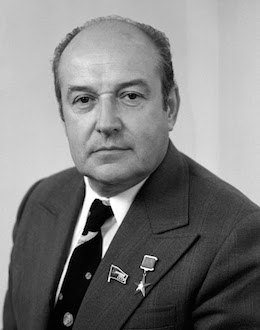
Aleksey Andreevich Tupolev was a Soviet and later Russian aircraft designer who led the development of the first supersonic passenger jet, the Tupolev Tu-144. He also helped design the Buran space shuttle and the long-range heavy bomber Tu-2000, both of which were suspended for lack of funding.

Sergei Nikitich Khrushchev was a Soviet-born American engineer and the second son of the Cold War-era Soviet Premier Nikita Khrushchev with his wife Nina Petrovna Khrushcheva. He moved to the United States in 1991 and became a naturalized American citizen.

Lorenzo Sumulong Sumulong Sr. was a Filipino politician who served in the Philippine Senate for four decades, and as a delegate of his country to the United Nations. He was noted for having engaged in a debate with Nikita Khrushchev at the United Nations General Assembly that (allegedly) provoked the Soviet Union Premier to bang his shoe on a desk.

Frederick Henry Boland was an Irish diplomat who served as the first Irish Ambassador to both the United Kingdom and the United Nations.

Dmitri Trofimovich Shepilov was a Soviet economist, lawyer and politician who served as Minister of Foreign Affairs. He joined the abortive plot to oust Nikita Khrushchev from power in 1957, and was denounced and removed from power. Rehabilitated after Khrushchev's downfall, he lived a largely obscure retirement.
Expedito Malvar Leviste was a member of the congress of the Philippines from the province of Batangas and a member of the Philippine delegation to the United Nations.

William Chase Taubman is an American political scientist. His biography of Nikita Khrushchev won the Pulitzer Prize for Biography in 2004 and the National Book Critics Circle Award for Biography in 2003.

Nina Khrushcheva is a professor of International Affairs at The New School in New York City, and a Contributing Editor to Project Syndicate: Association of Newspapers Around the World a funded project under the aegis of the Open Society Foundation.
Mikhail Vasilyevich Zimyanin was a Belarusian Soviet partisan, politician, and diplomat who served as the editor-in-chief of the newspaper Pravda, the official publication of the Communist Party of the Soviet Union, from 1965 to 1976. Afterwards, he was appointed to the party's secretariat. He retired on 28 January 1987 for "health reasons".
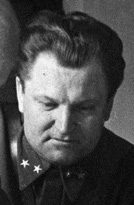
Aleksey Illarionovich Kirichenko was a Soviet Ukrainian politician, who was the first ethnic Ukrainian to head the republic's communist party during the Soviet era. Between 1957 and 1960, he was a Secretary of the Central Committee of the Communist Party of the Soviet Union and the second-highest-ranking official within the party after Nikita Khrushchev.

Collective leadership, or collectivity of leadership, was considered the ideal form of governance in the Union of Soviet Socialist Republics (USSR) and other socialist states espousing communism. Its main task was to distribute powers and functions among the Politburo and the Central Committee of the Communist Party of the Soviet Union, as well as the Council of Ministers, to hinder any attempts to create a one-man dominance over the Soviet political system by a Soviet leader, such as that seen under Joseph Stalin's rule. On the national level, the heart of the collective leadership was officially the Central Committee of the Communist Party. Collective leadership was characterised by limiting the powers of the General Secretary and the Chairman of the Council of Ministers as related to other offices by enhancing the powers of collective bodies, such as the Politburo.
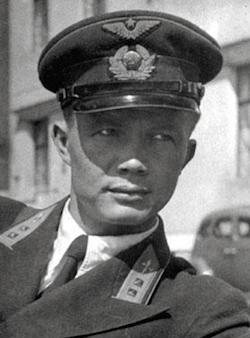
Leonid Nikitovich Khrushchev was the son of Nikita Khrushchev, former leader of the Soviet Union, and served as a fighter pilot in the Soviet Air Forces during the World War II. He was shot down and killed in 1943, but the exact circumstances of his death remain unknown.

Khrushchev: The Man and His Era is a 2003 biography of Soviet leader Nikita Khrushchev. Written by William Taubman, the book is the first in-depth and comprehensive American biography of Khrushchev. Taubman was the recipient of the 2004 Pulitzer Prize for Biography or Autobiography, as well as the 2004 National Book Critics Circle Award. The author spent almost 20 years researching the life of Khrushchev in preparation to write the book. Extensive research was made possible through access to archives in Russia and Ukraine, which were opened to the public following the collapse of the Soviet Union. In addition to printed materials and documentation, he spent time engaging Khrushchev's children and extended relatives, resulting in over 70 personal interviews. Taubman presents a historical narrative and study of the life of Nikita Khrushchev, the Soviet leader who succeeded Joseph Stalin. The book concludes with Khrushchev's death on September 11, 1971.

Sergei Ivanovich Safronov was a senior lieutenant in the Soviet Air Defense Forces. Safronov, a fighter pilot, was shot down by a friendly surface-to-air missile while attempting to intercept Gary Powers' U-2, conducting a reconnaissance mission.
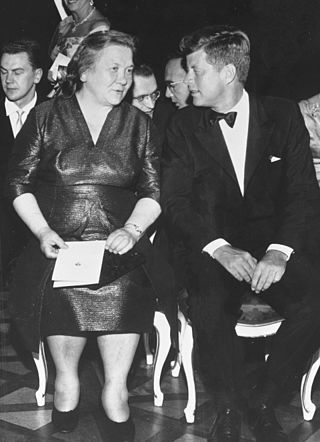
Nina Petrovna Khrushcheva was the second wife of the Soviet leader Nikita Khrushchev.

The state visit of Nikita Khrushchev to the United States was a 13-day visit from 15–27 September 1959. It marked the first state visit of a Soviet or Russian leader to the US. Nikita Khrushchev, then First Secretary of the Communist Party of the Soviet Union and Chairman of the Council of Ministers, was also the first leader of the Soviet Union to set foot in the Western Hemisphere. Being the first visit by a leader of his kind, the coverage of it resulted in an extended media circus.
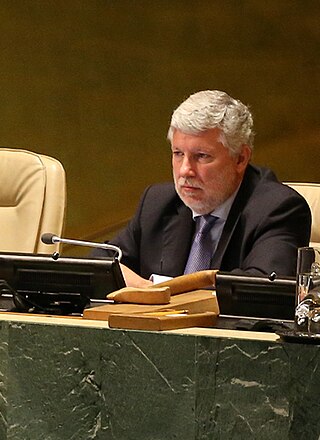
Thor's gavel, also known as Ásmundarnautur, is a ceremonial gavel, designed by sculptor Ásmundur Sveinsson, and originally given by Iceland and delivered to the General Assembly of the United Nations by ambassador Thor Thors in 1952. It is engraved with the phrase "Society must be built on the basis of laws" in both Icelandic and Latin. It is used by the President of the United Nations General Assembly and at the end of the General Assembly the gavel is ceremoniously passed from the current President to the next President.
For a detailed scholarly analysis of this incident giving the full context, see Thomas M. Prymak, "Cold War Clash, New York City, September-October 1960: Comrade Khrushchev vs 'Dief the Chief'," International History Review vol. 45, no. 1 (2023), 134-51.



















